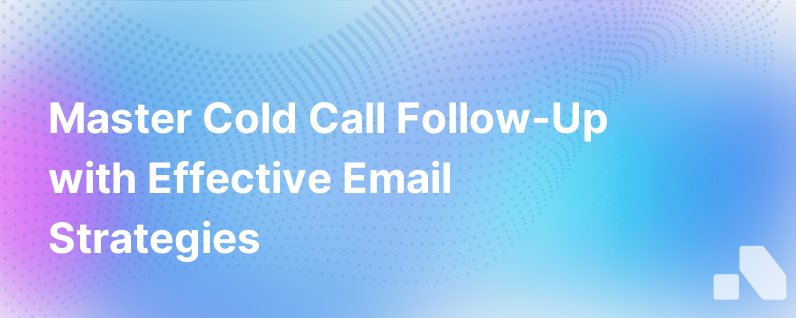
In the game of sales, cold calling can often feel like a swing in the dark — you're reaching out to potential prospects with the hope of sparking interest, but without a pre-existing connection to guide your pitch. While this process can be daunting, cold calling — or more specifically in our digital world, cold emailing — remains a crucial tactic in any sales strategy.
However, merely sending out an initial cold email isn't enough. The magic often happens in the follow-up. Yet, many sales professionals underestimate the power of a well-crafted cold call email follow-up strategy. It's here where persistence meets personalization, creating authentic connections that turn prospects into customers.
Why Follow-Up Emails Are Essential
The importance of follow-up emails cannot be overstated. Statistics show that the majority of sales require several points of contact before a deal is closed — often more than five. Without follow-up emails, you're not only cutting the conversation short but also potentially leaving significant opportunities on the table.
The Components of an Effective Follow-Up Email
An effective follow-up email should leave your prospect feeling valued and understood, not just another name in an endless sea of faceless contacts. It should be:
- Personalized: Address the recipient by name and include specific details relevant to their business challenges.
- Timely: Sent at an appropriate interval after the initial email, without being too pushy.
- Valuable: Provide additional information or insights that are beneficial to the recipient.
- Concise: Clear and to the point, respecting the recipient's time.
- Action-Oriented: Encourage a clear next step, whether that's scheduling a call, answering a question, or viewing a demo.
Crafting a Striking Subject Line
Your follow-up email is only as good as its open rate. A subject line that stands out is essential to entice the prospect to read on. A/B testing various subject lines is a great way to find what resonates best with your target audience. Some principles to consider are:
- Urgency: Creating a sense of urgency can prompt faster responses, but don’t overdo it as it might come across as salesy.
- Curiosity: Pique the prospect’s interest without giving away the entire content of the email.
- Relevance: Ideally, the subject line should reflect the recipient’s current business needs or interests.
Timing Your Follow-Up
There’s a fine line between being persistent and being annoying. Knowing when to send your follow-up email is crucial. Approximately 48-72 hours after the initial email is often a good place to start, but this can vary widely depending on industry standards and your understanding of the prospect's schedule.
Structuring Your Email
Your follow-up email should be well-structured and skimmable:
[Greeting]
[Personal connection/comment]
[Reiteration of value proposition]
[New piece of content or insight]
[Call to Action]
[Closing & Signature]
Personalization: The Key to Opening Doors
Tailor your message to the recipient's specific needs and industry. Comment on an achievement or unique challenge they recently faced, or even a mutual connection or interest. This shows that you’re not just sending out template emails, but that you've taken the time to understand who they’re directed at.
Reiteration of Value
Remind the prospect of the value you're offering. This is a chance to reinforce the key points from your initial email without sounding redundant. Explain how your solution can address their pain points or help them seize opportunities.
Educational Content
Providing value is about more than just making a sale; it's helping your prospect solve a problem or learn something new. In your follow-up, consider including whitepapers, case studies, or industry reports that may help them better understand their own needs and how your solutions align.
The Call to Action
Your CTA should be clear and concise, prompting a straightforward next step. Whether you want to set up a meeting or simply receive feedback on the provided materials, make sure that the action you want them to take is undeniably clear.
Examples of Follow-Up Email Templates
Below are a couple of templates refined for different follow-up scenarios:
When Your Initial Email Has Gone Without a Response:
Subject: Quick Question
Hello John,
I hope this message finds you well. I noticed that you had recently commented on the importance of [specific industry trend] on LinkedIn and I believe our recent whitepaper on [related subject] could provide you with some unique insights into this area.
I understand that you're extremely busy, but if you could spare 15 minutes, I'd love to discuss how we can help [Company] leverage these insights for better outcomes.
Looking forward to hearing your thoughts,
[Your Name]
After an Initial Phone Conversation:
Subject: Next Steps from Our Chat?
Hi Sarah,
Thank you for taking the time to speak with me today about [Company’s] challenges in [domain]. It was insightful to hear about [specific point from conversation].
As promised, attached is the case study I mentioned that highlights how we’ve helped companies like yours achieve [specific result].
Could we schedule a follow-up call next week to discuss how these strategies could be implemented at [Company]?
Best regards,
[Your Name]
Conclusion
The art of the follow-up is a delicate balance between persistence and respect for your prospect's attention and time. A thoughtful, targeted follow-up strategy can truly differentiate you from the competition. Effective follow-ups are personalized, timely, and always add value — turning cold prospects warm and ready for engagement.
Remember, even with the best tactics, not every cold call email follow-up will culminate in a sale. But with each well-crafted follow-up, you're building stronger industry connections and learning what resonates with your prospects. These insights are invaluable for refining your approach and enhancing your long-term sales success.